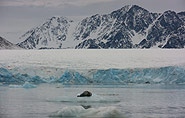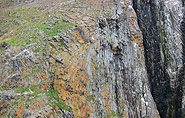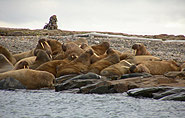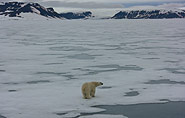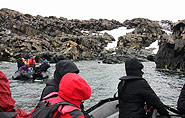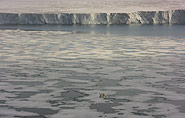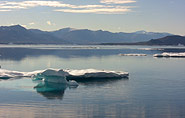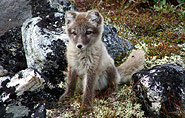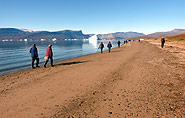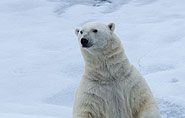Circumnavigating Spitzbergen with Kvitoya
Day 1 - Arrive in Longyearbyen, the administrative capital of the Spitsbergen archipelago of which West Spitsbergen is the largest island. Before embarking there is an opportunity to stroll around this former mining town, whose parish church and Polar Museum are well worth visiting, while in the surrounding area of Longyearbyen. In the early evening the ship will sail out of Isfjorden.
Day 2 - On the offshore island of Ytre Norskøya, we visit a 17th century Dutch whaling site, whose large graveyard is a reminder of the hardships and dangers of life here at that time. The island’s bird life is prolific, with colonies of Little Auk, Black Guillemot, Brünnich’s Guillemot, Puffin and Arctic Skua accessible to visitors. Eastwards, we visit Raudfjord on the north coast of West Spitsbergen, a beautiful fjord dominated by spectacular glaciers and favoured by Ringed and Bearded Seal. The cliffs and shoreline of the fjord also support thriving seabird colonies. In the evening we will sail by the island of Moffen where a big herd of Walrus can be found.
Day 2 - On the offshore island of Ytre Norskøya, we visit a 17th century Dutch whaling site, whose large graveyard is a reminder of the hardships and dangers of life here at that time. The island’s bird life is prolific, with colonies of Little Auk, Black Guillemot, Brünnich’s Guillemot, Puffin and Arctic Skua accessible to visitors. Eastwards, we visit Raudfjord on the north coast of West Spitsbergen, a beautiful fjord dominated by spectacular glaciers and favoured by Ringed and Bearded Seal. The cliffs and shoreline of the fjord also support thriving seabird colonies. In the evening we will sail by the island of Moffen where a big herd of Walrus can be found.
Day 3 - We sail through Beverleysundet named by Parry in 1827 and also sailed by the Swedish-Russian Arc-of-Meridian Expedition in 1898. Today we will reach our northernmost point at Phippsøya, in the Seven Islands north of Nordaustlandet. Here we will be at 81 degrees north, just 540 miles from the geographic North Pole. Polar Bear inhabit this region, along with Ivory Gull.
Day 4 - We push east to reach the area of Nordaustlandet, where the Nobile expedition drifted around in 1928 and where the Italian Sora tried to come to the rescue. There we hope to get to Alpinøya, reached by Sora in 1928, and then to the mouth of Finn Malmgrenfjord, and Albertinibukta and to climb Soraberget (205 M) from where we have a fantastic view on the icecap of Nordaustlandet. Alternatively we will land at Storøya, where again we may meet a group of Walrus.
Day 5 - Today we hope to get to the rarely visited Kvitøya farthest to the east, close to the Russian territory. The island is dominated by an icecap, which leaves a small area bare of ice and snow. We will land at the western tip at Andréneset, where the Swedish explorer André and his companions perished in 1898. We will also try to get to Kraemerpynten in the east, where an enormous group of Walrus resides.
Day 4 - We push east to reach the area of Nordaustlandet, where the Nobile expedition drifted around in 1928 and where the Italian Sora tried to come to the rescue. There we hope to get to Alpinøya, reached by Sora in 1928, and then to the mouth of Finn Malmgrenfjord, and Albertinibukta and to climb Soraberget (205 M) from where we have a fantastic view on the icecap of Nordaustlandet. Alternatively we will land at Storøya, where again we may meet a group of Walrus.
Day 5 - Today we hope to get to the rarely visited Kvitøya farthest to the east, close to the Russian territory. The island is dominated by an icecap, which leaves a small area bare of ice and snow. We will land at the western tip at Andréneset, where the Swedish explorer André and his companions perished in 1898. We will also try to get to Kraemerpynten in the east, where an enormous group of Walrus resides.
Tag 6 - South of Nordaustlandet we will try to land at Isispynten a Nunatak area surrounded by glaciers. Later we sail along the front of the Brasvell Glacier, the longest glacier front in Spitsbergen. In Olga Strait we have chances to spot the elusive Greenland Whale.
Day 7 – We will sail through the seldom visited area of Kong Karls Land, which is a Polar Bear reserve, where we are not allowed to land, but where we can make a zodiac cruise. Alternatively we land in Blafjordflya at the east side of Edgeöya, a vast tundra area with a lot of reindeer.
Day 8 - In Freemansundet we plan to land at Sundneset on the island of Barentsøya to visit an old trapper's hut and then take a brisk walk across the tundra in search of Spitsbergen Reindeer and Barnacle Goose. Later we cruise south to Diskobukta on the west side of Edgeøya. After a Zodiac cruise through the shallow bay, we land on a beach littered with whale bones and tree trunks, which have drifted here from Siberia. We can also climb to the rim of a narrow gully which is inhabited by thousands of Kittiwake, together with Black Guillemot and piratical Glaucous Gull. During the breeding season, the base of the cliffs is patrolled by Arctic Fox and Polar Bear, searching for young birds that have fallen from the nesting ledges.
Day 7 – We will sail through the seldom visited area of Kong Karls Land, which is a Polar Bear reserve, where we are not allowed to land, but where we can make a zodiac cruise. Alternatively we land in Blafjordflya at the east side of Edgeöya, a vast tundra area with a lot of reindeer.
Day 8 - In Freemansundet we plan to land at Sundneset on the island of Barentsøya to visit an old trapper's hut and then take a brisk walk across the tundra in search of Spitsbergen Reindeer and Barnacle Goose. Later we cruise south to Diskobukta on the west side of Edgeøya. After a Zodiac cruise through the shallow bay, we land on a beach littered with whale bones and tree trunks, which have drifted here from Siberia. We can also climb to the rim of a narrow gully which is inhabited by thousands of Kittiwake, together with Black Guillemot and piratical Glaucous Gull. During the breeding season, the base of the cliffs is patrolled by Arctic Fox and Polar Bear, searching for young birds that have fallen from the nesting ledges.
Day 9 - We start the day quietly cruising the side fjords of the spectacular Hornsund area of southern Spitsbergen, enjoying the scenery of towering mountain peaks. Hornsundtind rises to 1,431m, while Bautaen shows why early Dutch explorers gave the name ‘Spitsbergen’ - pointed mountains - to the island. There are also 14 magnificent glaciers in the area and very good chances of encounters with seals and Polar Bear. We may visit the Polish research station where the friendly staff will give us an insight into their research projects. Behind the station the mountains are home to thousands of pairs of nesting Little Auk.
Tag 10 - Today we land on Ahlstrandhalvøya at the mouth of Van Keulenfjorden. Here piles of Beluga skeletons (the Beluga is a small white whale), the remains of 19th century slaughter, are yet another reminder of the consequences of thoughtless exploitation. Fortunately, Beluga were not hunted to the edge of extinction and may still be seen locally. Indeed, there is a good chance that we will come across a pod. Cruising into Recherchefjorden during the afternoon we can explore an area of tundra at the head of the fjord where many reindeer feed.
Tag 11 - Return to Longyearbyen and disembark for the transfer to the airport and the flight to Oslo and home.
Tag 11 - Return to Longyearbyen and disembark for the transfer to the airport and the flight to Oslo and home.
Please note:
The chances that we can complete a full Spitsbergen Circumnavigation (based on our experiences from 1992 until 2012) are about, 90 % in the first half of August, 95% in the second half of August. In case we cannot complete a full circumnavigation including Nordaustalandet, we will sail through Hinlopen Street.
The chances that we can complete a full Spitsbergen Circumnavigation (based on our experiences from 1992 until 2012) are about, 90 % in the first half of August, 95% in the second half of August. In case we cannot complete a full circumnavigation including Nordaustalandet, we will sail through Hinlopen Street.


